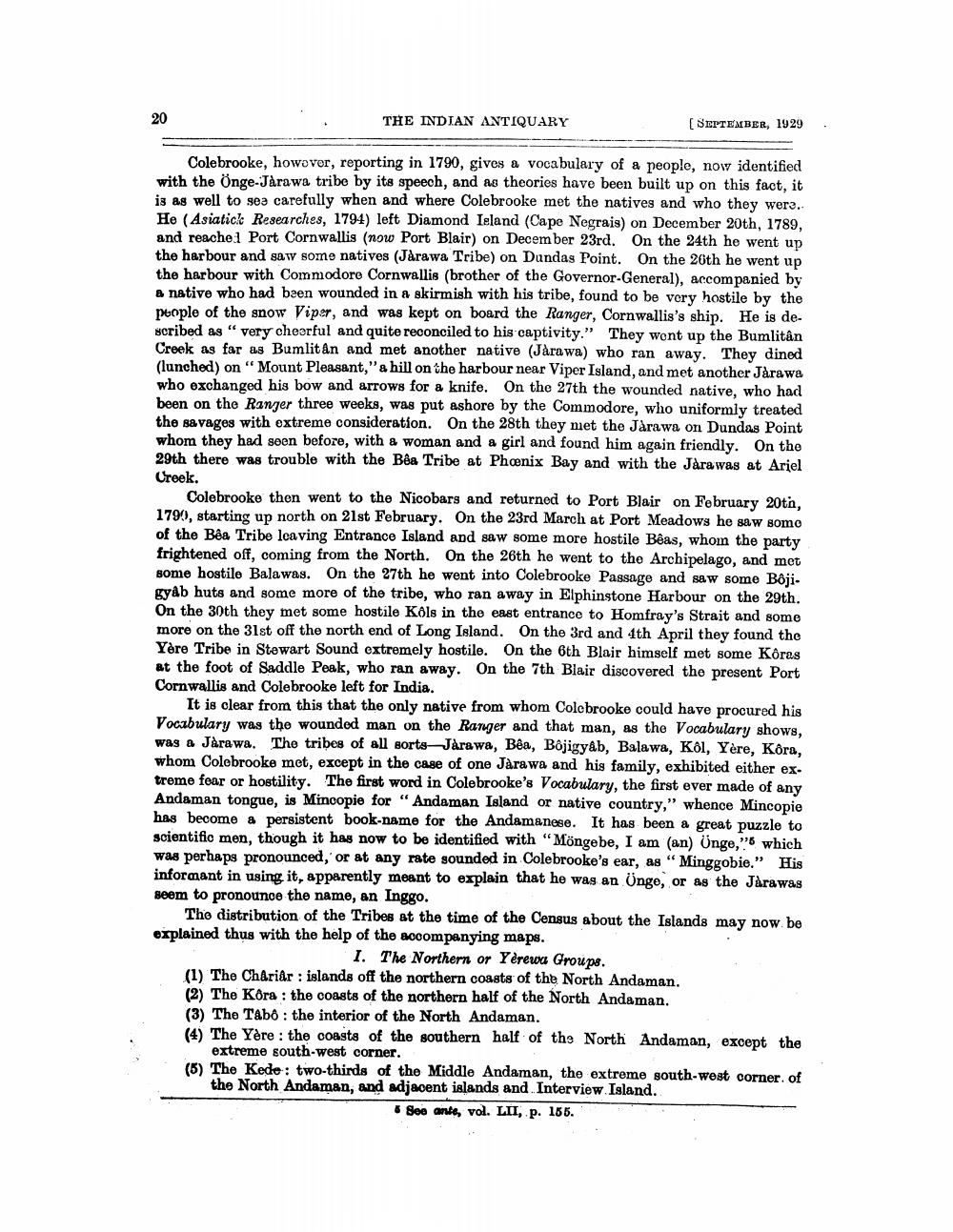________________
20
THE INDIAN ANTIQUARY
(SEPTEMBER, 1929
.
Colebrooke, however, reporting in 1790, gives a vocabulary of a people, now identified with the Önge-Járawa tribe by its speech, and as theories have been built up on this fact, it is as well to sea carefully when and where Colebrooke met the natives and who they wers. He (Asiatic.c Researches, 1794) left Diamond Island (Cape Negrais) on December 20th, 1789, and reache1 Port Cornwallis (now Port Blair) on December 23rd. On the 24th he went up the harbour and saw some natives (Járawa Tribe) on Dundas Point. On the 20th he went up the harbour with Commodore Cornwallis (brother of the Governor-General), accompanied by a native who had been wounded in a skirmish with his tribe, found to be very hostile by the people of the snow Viper, and was kept on board the Ranger, Cornwallis's ship. He is de. scribed as " very cheerful and quite reconciled to his captivity." They went up the Bumlitân Creek as far as Bumlitân and met another native (Járawa) who ran away. They dined (lunched) on "Mount Pleasant, "a hill on the harbour near Viper Island, and met another Járawa who exchanged his bow and arrows for a knife. On the 27th the wounded native, who had been on the Ranger three weeks, was put ashore by the Commodore, who uniformly treated the savages with extreme consideration. On the 28th they met the Jarawa on Dundas Point whom they had seen before, with a woman and a girl and found him again friendly. On the 29th there was trouble with the Bea Tribe at Phoenix Bay and with the Jarawas at Ariel Creek.
Colebrooke then went to the Nicobars and returned to Port Blair on February 20tn, 179.), starting up north on 21st February. On the 23rd March at Port Meadows he saw somo of the Bêa Tribe Icaving Entrance Island and saw some more hostile Beas, whom the party frightened off, coming from the North. On the 26th he went to the Archipelago, and met some hostile Balawas. On the 27th he went into Colebrooke Passage and saw some Bôji. gyâb huts and some more of the tribe, who ran away in Elphinstone Harbour on the 29th. On the 30th they met some hostile Kols in the east entrance to Homfray's Strait and some more on the 31st off the north end of Long Island. On the 3rd and 4th April they found the Yère Tribe in Stewart Sound extremely hostile. On the 6th Blair himself met some Kôras at the foot of Saddle Peak, who ran away. On the 7th Blair discovered the present Port Cornwallis and Colebrooke left for India.
It is clear from this that the only native from whom Colebrooke could have procured his Vocabulary was the wounded man on the Ranger and that man, as the Vocabulary shows, was a Járawa. The tribes of all sorts—Járawa, Bêa, Bôjigyab, Balawa, Kol, Yere, Kôra, whom Colebrooke met, except in the case of one Jarawa and his family, exhibited either extreme fear or hostility. The first word in Colebrooke's Vocabulary, the first ever made of any Andaman tongue, is Minoopie for "Andaman Island or native country," whence Mincopie has become a persistent book-name for the Andamanese. It has been a great puzzle to scientific men, though it has now to be identified with "Möngebe, I am (an) Önge," which was perhaps pronounced, or at any rate sounded in Colebrooke's ear, as "Minggobie." His informant in using it, apparently meant to explain that he was an Unge, or as the Jarawas seem to pronounce the name, an Inggo.
The distribution of the Tribes at the time of the Census about the Islands may now be explained thus with the help of the accompanying maps.
1. The Northern or Yerewa Groups. (1) The Chariar : islands off the northern coasts of the North Andaman. (2) The Kora : the coasts of the northern half of the North Andaman. (3) The Tabo: the interior of the North Andaman. (4) The Yère : the coasts of the southern half of the North Andaman, except the
extreme south-west corner. (5) The Kede: two-thirds of the Middle Andaman, the extreme south-west corner of the North Andaman, and adjacent islands and Interview Island.
6 See ante, vol. LII, p. 156.




